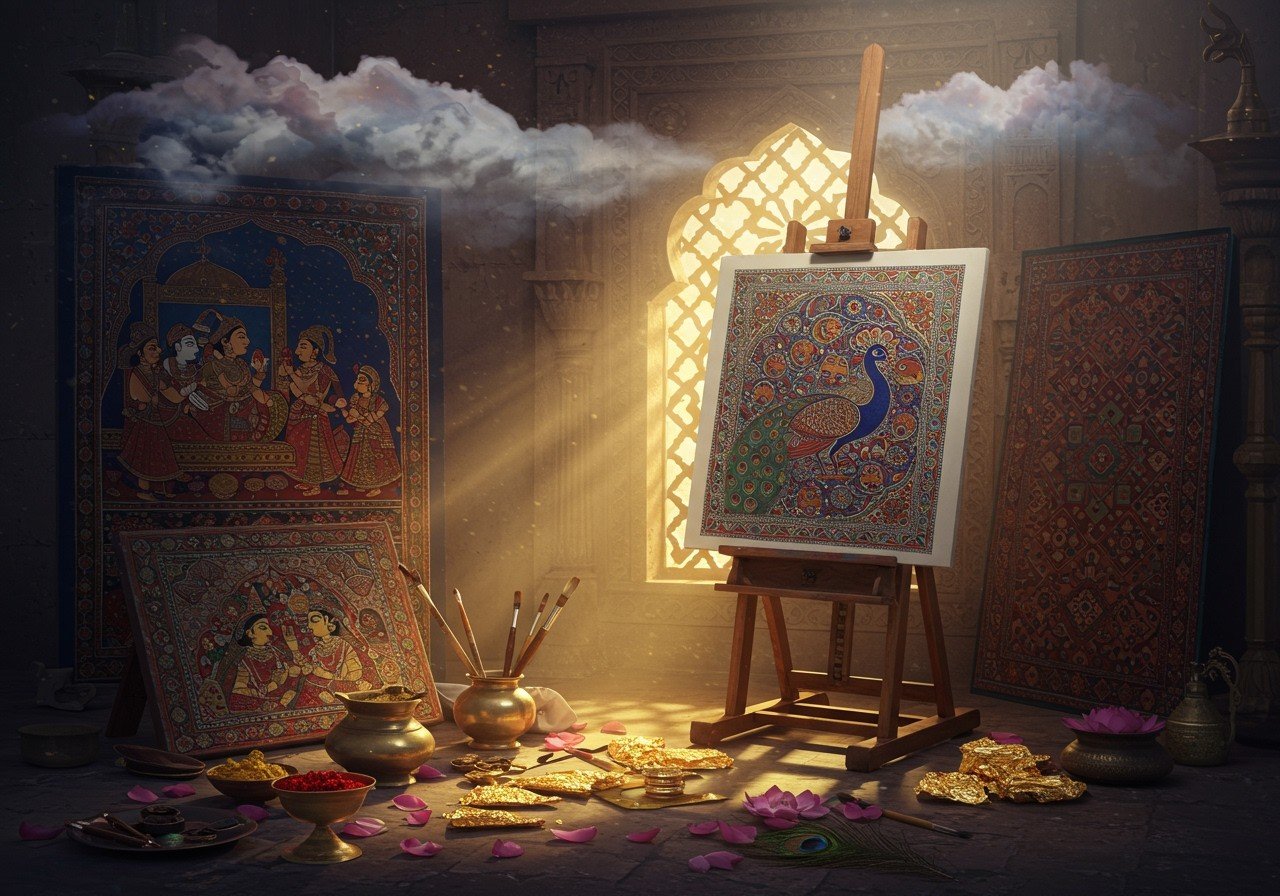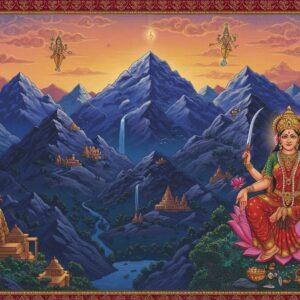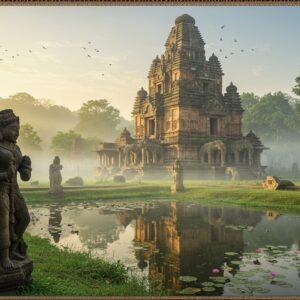
Indian paintings offer a vibrant tapestry of the country’s rich heritage. These artworks narrate stories, beliefs, and traditions that have shaped Indian culture. With each brushstroke, they capture the essence of India’s history and spirituality. They serve as a powerful medium of expression, conveying emotions, narratives, and cultural values across generations. Explore the spiritual significance of Indian art further with resources like Ramayana’s Influence on Hindu Spirituality.
Indian paintings are not just about colors and designs; they embody a profound connection to the past and a reflection of the multifaceted Indian identity. They also provide a unique lens through which to understand India’s diverse regional and cultural nuances, making them a valuable resource for both scholars and art enthusiasts.
What is Indian Painting?
Indian painting forms a significant part of India’s cultural legacy. They range from intricate miniatures to grand murals, each style offering a unique glimpse into the past. The use of vibrant colors and symbolic motifs sets Indian paintings apart. These elements add layers of meaning and symbolism to the artworks, enriching the viewer’s experience. Consider adding a touch of traditional art to your home with Traditional Keya Kouto Sindur Dibbi from Poojn.in.
These artworks often depict deities, mythological tales, and spiritual themes. Historically, Indian paintings have transformed from ancient murals to contemporary art. Royal and religious patronage has nurtured their evolution, offering support that allowed artists to explore new styles and techniques. Traditionally, artists used natural dyes, handmade paper, and unique brushes, creating pieces that are not only beautiful but also environmentally harmonious. Each region in India boasts its distinct painting style, reflecting the diverse cultural landscape.
Indian Painting Art Forms
Indian paintings include a variety of art forms, each with its own charm and cultural significance. Miniature paintings, for instance, are known for their detailed depictions of court scenes and nature. These small-scale artworks often showcase intricate details and vibrant colors, offering a glimpse into the lives and aesthetics of royal courts. Consider exploring Hinduism’s Impact on Indian Art and Culture for a deeper understanding.
Mural paintings adorn temple and palace walls, illustrating religious stories and historical events. These large-scale artworks often served as visual narratives, educating and inspiring viewers with depictions of mythology, history, and cultural values. Discover traditional Gold Sindoor at Poojn.in to enhance your spiritual practices.
Folk and tribal paintings like Warli, Madhubani, and Pattachitra portray everyday life and beliefs of indigenous communities. These art forms offer a unique window into the cultural expressions and worldviews of different tribal groups. The Mughal era saw a blend of Indian and Persian art styles, resulting in a rich fusion that continues to influence artists today. Contemporary Indian art combines traditional techniques with modern themes, offering fresh perspectives on age-old traditions.
Indian Painting Styles
The diversity of Indian painting styles reflects the country’s cultural richness. The Mughal style, with its detailed portrayal of flora, fauna, and court life, remains iconic. This style showcases a blend of Persian and Indian influences, resulting in opulent and detailed artwork. Enhance your understanding of Mughal influences with Poojn.in’s curated collection of Maa Lakshmi statues.
The Rajput style is celebrated for its vibrant colors and romantic themes, often seen in Rajasthan’s palaces. These paintings often depict scenes from Hindu epics and local folklore, showcasing the region’s rich storytelling traditions. Celebrate the vibrant colors of Rajput art with Poojn.in’s blog post on Holi.
The Pahari style, emerging from the Himalayan foothills, depicts Hindu mythology and pastoral life. This style is known for its serene landscapes and depictions of deities in natural settings. The Bengal School of Art revived traditional Indian art forms, countering Western influences during colonial times. In South India, the Tanjore style is renowned for its rich colors and gold foil used in religious themes. Delve deeper into South Indian temple art with Poojn.in’s guide to the Sri Sri Kalika Maharani Temple.
Colonialism brought significant changes to Indian painting styles, paving the way for modern art forms. Art schools played a crucial role in preserving these diverse styles, ensuring they continue to inspire future generations.
Indian Paintings: A Window to India’s Soul
Indian paintings are more than just visual art; they are stories waiting to be discovered. Whether you’re an art enthusiast or a curious admirer, these artworks invite you to explore India’s vibrant heritage through the lens of its artists. They provide a tangible link to the past, allowing us to connect with the cultural and spiritual traditions that have shaped India for centuries. Further your exploration of Indian art with Poojn.in’s article on the Ramayana’s impact on art and literature.
A Brief Overview of Indian Art History
- Early Beginnings (3rd millennium BCE): Prehistoric settlements like the Bhimbetka rock shelters showcase some of the world’s oldest cave paintings, offering a glimpse into early artistic expressions. The Indus Valley Civilization (c. 2500-1800 BC) produced terracotta and bronze sculptures, pottery, and seals, demonstrating early artistic skills and cultural practices. These artifacts provide valuable insights into the daily lives and beliefs of ancient Indian civilizations.
- Ancient Period (2nd century BCE – 8th-10th century CE): This period marks the flourishing of mural painting in India, adorning the walls of caves, temples, and palaces with vibrant depictions of religious and secular themes. These murals offer a visual record of ancient Indian history, mythology, and cultural practices, showcasing the evolution of artistic styles and techniques over time.
- Religious Influences: Religions like Hinduism, Buddhism, Jainism, Sikhism, and Islam have profoundly impacted Indian art, shaping its themes, iconography, and artistic styles. Despite their diverse origins, these religions often shared artistic expressions, contributing to a rich tapestry of artistic traditions across the Indian subcontinent. The interplay of religious beliefs and artistic creation resulted in a unique and diverse body of artwork that reflects the spiritual landscape of India.
- Sculpture (Ancient to Modern): Sculptures in stone and metal, primarily religious, have withstood the Indian climate, becoming primary remnants of historic Indian art. These sculptures, often depicting deities and mythological figures, showcase the skill and artistry of ancient Indian sculptors, offering insights into religious beliefs and cultural practices.
- Painting (Prehistoric to Modern): From prehistoric rock paintings in Bhimbetka to intricate miniature paintings and contemporary art forms, Indian painting encompasses a vast range of styles and techniques. These paintings reflect the country’s rich history, mythology, and cultural diversity, serving as a visual record of India’s artistic evolution over millennia.
- Mughal Influence (16th-19th century): The Mughal Empire introduced Islamic culture, significantly influencing Indian paintings, sculptures, and architecture. This fusion of artistic traditions led to the development of new styles and techniques, enriching the artistic landscape of India.
- British Colonial Rule (1857-1947): British colonialism impacted Indian art, with Western art gaining prominence and traditional patrons losing influence. This period saw the establishment of art schools in major cities and the emergence of the “Company style” of painting, catering to European tastes. This colonial influence led to a complex interplay between traditional Indian art forms and Western artistic styles.
- Modernization (Post-1947): Post-independence, Indian art has evolved under the influence of global events, cultural shifts, and technological advancements, shaping contemporary artistic practices.
How Poojn.in Supports Your Appreciation of Indian Art
Poojn.in offers a carefully selected collection of traditional Indian paintings that bring spiritual and cultural significance to your home. Our collection includes:
- Tanjore Paintings: Authentic gold-leaf paintings featuring deities like Krishna, Ganesha, and Lakshmi, handcrafted by skilled artisans.
- Madhubani Art: Traditional Bihar folk paintings depicting religious scenes and natural elements, showcasing the region’s unique artistic style.
- Pattachitra: Ancient scroll paintings from Odisha showcasing mythological narratives, preserving ancient storytelling traditions.
- Miniature Paintings: Detailed artworks in Rajasthani and Mughal styles, offering intricate depictions of courtly life and religious themes.
Each painting at Poojn.in comes with:
- Certification of authenticity
- Secure packaging for safe delivery
- Detailed product descriptions explaining the artwork’s religious significance
- Multiple size options to suit your space
- Expert guidance on placement according to Vastu principles
Visit Poojn.in to explore our collection of traditional Indian paintings. We deliver across India and provide customer support to help you choose the right artwork for your puja room or living space.
[Note: Please check our website for current availability and pricing of paintings]
Celebrating Indian Paintings
Indian paintings are treasures that connect us to the heart of India’s cultural legacy. Each piece is a window into the stories, beliefs, and traditions that have shaped this diverse land. From the delicate strokes of miniatures to the grandeur of murals, Indian art invites us to witness the past and embrace the rich tapestry of heritage. These artworks hold a timeless beauty, reflecting the spirit of India through every brushstroke and color.
As you explore Indian paintings, you become part of a journey that spans centuries. Whether you hang a piece in your home or admire it in a gallery, you carry forward a tradition that honors history and celebrates creativity. Let these paintings be a source of inspiration, a reminder of India’s vibrant culture, and a testament to the enduring power of art.


